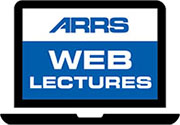In-Bore and Fusion MRI-guided Biopsy of PI-RADS Category 4 and 5 Lesions
The AJR Lecture Series brings presentations on the most important AJR articles to your desktop, available for viewing at home or office and on your schedule. This Lecture has an estimated time to complete the activity of 1 hour.
Target Audience:
The target audience for this activity is radiologists at all training levels with an interest in prostate imaging.
Goals and Objectives:
After completing the material in this article, the learner should be able to:
- Describe the differences between in-bore and fusion-ultrasound-MRI guided biopsy strategies for diagnosis of prostate cancer in PI-RADS category 4 and 5 lesions;
- Explain the potential advantages and potential disadvantages of in-bore versus fusion-ultrasound-MRI guided biopsy strategies for diagnosis of prostate cancer in PI-RADS category 4 and 5 lesions; and
- Report the potential incremental benefit of in-bore MRI guided targeted biopsy compared to fusion-ultrasound-MRI guided biopsy of prostate lesions detected on MRI.
Disclosure of Commercial Interest:
- N. Schieda has nothing to disclose
- F. Coakley is the inventor and founder of OmnEcoil Instruments, Inc.
- C. Neumann has nothing to disclose.
Member Price:
Free
NonMember Price:
$250.00
Accreditation Statement
The American Roentgen Ray Society (ARRS) is accredited by the Accreditation Council for Continuing Medical Education (ACCME) to provide continuing medical education activities for physicians.
Designation Statement
The ARRS designates this educational activity for a maximum of 1 AMA PRA Category 1 Credit(s)™. Physicians should claim only the credit commensurate with the extent of their participation in the activity.
The American Medical Association has determined that physicians not licensed in the US who participate in this CME activity are eligible for AMA PRA Category 1 Credit(s)™.
Date of issuance: May 21, 2021
Date of expiration: May 20, 2024
Estimated time to complete the activity: 1 hour(s)
The American Roentgen Ray Society (ARRS) is accredited by the Accreditation Council for Continuing Medical Education (ACCME) to provide continuing medical education activities for physicians.
Designation Statement
The ARRS designates this educational activity for a maximum of 1 AMA PRA Category 1 Credit(s)™. Physicians should claim only the credit commensurate with the extent of their participation in the activity.
The American Medical Association has determined that physicians not licensed in the US who participate in this CME activity are eligible for AMA PRA Category 1 Credit(s)™.
Date of issuance: May 21, 2021
Date of expiration: May 20, 2024
Estimated time to complete the activity: 1 hour(s)
